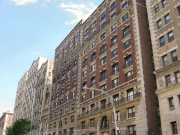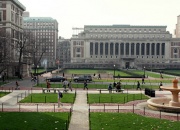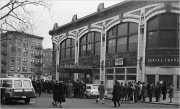From A Neighborhood in Transition
Contents |
Gentrification
What is Gentrification?
The Ivy Leagues, a group of eight institutions in the Eastern United States, are reputed for the academic excellence of their student bodies. The tuition at Columbia University is approximately $40,000 annually. Soon however, it might become more expensive to live around Columbia University than to be a student there. How can this phenomenon be explained? Gentrification. For the past few decades or so, Columbia University has significantly expanded its real-estate holdings in the area surrounding its campus. From the buildings to the businesses, the neighborhood displays a very distinct elitist characteristic that has come to be associated to Columbia University.
Gentrification is widely described as the movement of people of higher social standing into less opulent neighborhoods. The term is mostly associated with urban movement since cities are most likely to house people from all levels of the social hierarchy. Also, the growing population of cities has created a dearth in the availability of housing, even for the rich. As a result, many developers have taken steps to increase the expansion of neighborhoods and availability of houses for the wealthy. This process, although formally referred to as urban development, is dubbed by many as slum-clearing. While urban development has increased the availability of housing in many areas around the city, it has inevitably raised the cost of living, from the sky-rocketing leases to the posh restaurants and snobby businesses. Much of the same can be said about the Morningside Heights area, where Columbia University’s expansion projects have created a neighborhood that is gradually infiltrating into the greater, less-developed Harlem.
It is therefore not surprising that for many whose neighborhoods have undergone such urban development, gentrification is viewed as a usurpation of the social elite. It is not that such persons are against development; it is rather that they can no longer afford to live in their own neighborhood. This is what apprehends most residents, why the term ‘gentrification’ has garnered a negative connotation; the notion that their way of life will be taken away from them, all in the name of a development that they cannot even enjoy or benefit from. If what follows gentrification is a loss of local culture, where long-time residents can no longer recognize their own neighborhood, and the meaning of home and regional identity is snatched from the locals, then the city and its neighborhoods such as Morningside Heights has no place for such development.
Columbia's Gentrification of Morningside Heights
Though both past and current residents argue that Morningside Heights has no room for further development and that any such action would disrupt the already existing communities, it has not stopped Columbia University from pursuing gentrification of the neighborhood. Columbia’s privatization of community facilities has been displacing low-income families for the last half century and can be dated back to 1947. In 1947, Columbia teamed up with other neighborhood institutions to form Morningside Heights Inc. The group was initially founded and led by David Rockefeller with the goal of removing what he and the rest of the coalition deemed “undesirables”. The “undesirables” were essentially low-income residents that lived in crowded apartment building and single-room hotels in the area. Prior to that time, Morningside had been home to a predominantly working-class population. Since most of the residents were primarily low-income families, students in the neighborhood were the beneficiaries of the low rent in the area. The most affected groups were African-American and Puerto Rican families that sought the low-income housing that Morningside made available. These groups were targeted by MHA in an attempted to ensure that the area between 110th and 120th streets (west of Morningside Park) were free of low-income minority populations. With Columbia leading the assault, MHA purchased much of the private housing stock and pressured New York City agencies to begin “slum-clearance” projects to gentrify the neighborhood. This catalyst eventually sparked major demographic change from the 1950s to the present-day.
Eventually, sustained lobbying efforts by the Morningside Heights Inc resulted in the demolition of everything on the blocks bound by West 123rd St., Tiemann Place, West 125th St., LaSalle St., spanning Broadway to Amsterdam Ave., and from Amsterdam Ave. to Morningside Ave, under eminent domain laws. The areas closest to Columbia University were made into Morningside Gardens and Grant Houses— subsidized co-op housing development for middle-income. By 1957, both Morningside Gardens and Grant Houses were ready for occupancy. The former residents of the demolished property were all low-income families. The new developments would then serve as a buffer zone between Columbia and the poorer neighborhoods above 125th St. The construction of Morningside Gardens made way for what would be the homogenization of a mostly middle-class constituency. As Morningside further gentrified in the 1980s and1990s, becoming a mostly wealthy neighborhood, Morningside Garden became the closest to affordable housing for the middle-class. This too ultimately ended in 2006, when the board of Morningside Gardens abandoned its rules keeping the prices of apartments down. Now housing is mostly available at market-rate prices.
Columbia began the construction of a private gym for students and faculty in Morningside Park in 1968. The construct faced vehement opposition not only because it was privatizing public property, but because the project had ulterior motives on grounds of racism. A mostly Caucasian institution, Columbia was seen as stripping the mostly African-American community of Harlem of parkland, sparking fears that the gym would only be the first of developmental projects in the region. Harlem residents gathered on the Columbia campus, along with Columbia students and took over campus buildings, causing the university to shutdown for the rest of the term. In response, Columbia ended its pursuit of Morningside Park and abandoned any plans to build facilities there.
A fire in 1983 caused damage to a Riverside Drive building, a 21 unit apartment building that Columbia had purchased 16 years prior. Like many of Columbia’s other acquisitions, 547 Riverside Drive had community residents that lived in the building for many years. Additionally, rent laws protected the rights of these residents to remain indefinitely at minimal rent increase. Columbia was only allowed to acquire units as existing tenants moved out voluntarily. The fire however, forced tenants to temporarily leave for safety reasons. Columbia exploited the situation and claimed 13 of the 21 units that belonged to residents. Only four apartments had been damaged by the fire, and it would have taken little time to reoccupy those buildings. Columbia claimed that it was not obligated to make repairs to the building, ensuring no tenants moved back in by allowing the fire department’s order to prevent access to building stay in effect for an elongated period of time. Tenants were placed in temporary housing for years, while their homes received no repairs. By keeping the tenants in scattered locations throughout the city, Columbia coercing tenants to slowly sign away their rights. The only way Columbia would be able to free itself from its obligations would be by demolishing the building and rebuilding a similar one. By the end of construction, the dramatically gentrified Morningside neighborhood was no longer an affordable place to live for rent-stabilized residents.
In 1994, Columbia demolished the Audubon Ballroom on Broadway between 165th and 166th St. The Audubon Ballroom was considered to be a historic landmark for many reasons, but most notably because it was the place where Malcolm X was assassinated. Columbia continued to develop the spot for medical school laboratories and left a small part for a small memorial for Malcolm X. Columbia’s refusal to hear pleas of the site’s preservation further substantiated claims that the university did not care for its neighboring communities and their ethnic constituencies. In 1992, students blockaded Hamilton Hall on the Columbia campus to protest plans for the demolition of the Audubon Ballroom. The students were disciplined and even suspended for their protest.
Columbia began demolition of the Audubon Ballroom on Broadway between 165th and 166th streets in 1994, which the university had purchased in 1983. The Audubon Ballroom was considered by many to be vital historic landmark for many reasons, but most notably because it was the spot where Malcolm X was assassinated. Columbia commenced with its proposal to develop the site for use as medical school laboratories, and only agreed to retain a portion of the façade (while constructing a high-rise inside the footprint) and to install a small memorial to Malcolm X in the building. Columbia's unwillingness to consider repeated calls for the site to be preserved further substantiated arguments that Columbia has shown little regard for its neighboring communities of Harlem and Washington Heights, and even less for the importance of the area's resources and cultural sites to the African-American community. In 1992, students blockaded Hamilton Hall on the campus of Columbia to protest plans for the destruction of Audubon Hall; three students were suspended and 45 others were disciplined for their participation in the protest.
Timeline of Columbia's Gentrification of Morningside Heights







